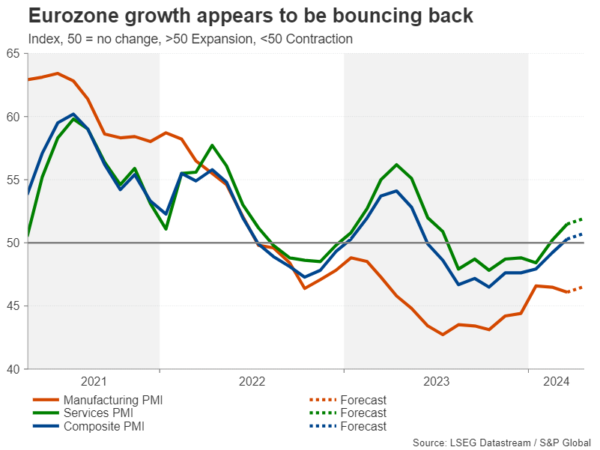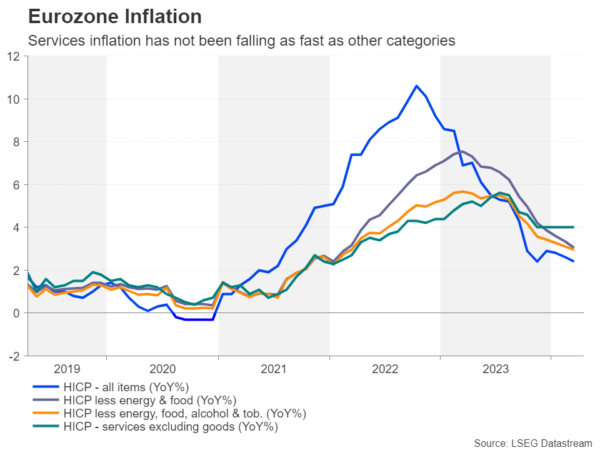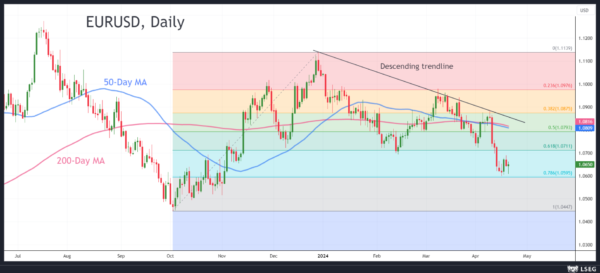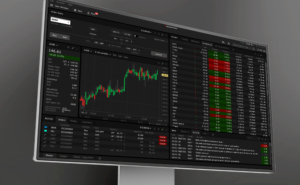- Eurozone appears to be on the mend but ECB still on track to cut in June
- For the euro, rate outlook beyond June increasingly more important
- Flash PMI readings for April are due on Tuesday, 08:00 GMT
Will PMIs confirm tepid recovery signs?
The euro area economy stagnated in the middle of 2023 but narrowly managed to dodge a technical recession, defined as two consecutive quarters of negative growth. The most recent data have been somewhat more upbeat, and the Eurozone may be turning a corner.
Services activity expanded in the previous two months according to the S&P Global surveys, and while the manufacturing sector remains in deep water, this was enough to lift the overall composite PMI to above 50.0 for the first time since May 2023.
With China’s economic recovery also gaining some traction and the energy crisis fading, there is hope that the pain for Europe’s manufacturers will ease more substantially in the coming months.

Forecasts point to a further pickup in the services PMI to 51.9 and for the manufacturing PMI to have improved to 46.5 in April.
Waiting for the final piece of the jigsaw
For policymakers at the European Central Bank, the number one concern is of course inflation, and on that front, things are also looking up. Headline inflation fell to 2.4% in March and underlying measures have been trending lower all year, unlike in the US where progress has been mixed.
Some ECB officials were ready to cut in April, but most Governing Council members including President Lagarde are not yet totally convinced. In particular, services inflation remains problematic, and for policymakers to become more confident that services CPI, currently stuck at 4.0%, won’t become sticky, they would have to see wage pressures cool off.

Services prices tend to be more strongly correlated with wage growth than manufacturing prices so the ECB is awaiting Q1 figures on negotiated wages due at the end of May to get the all clear to cut in June.
Rate cut hopes dealt a setback
In this respect, the PMI numbers won’t pose a hurdle to June rate cut prospects. However, they may shape expectations for the rate path beyond June. Rate cut bets for central banks globally have been scaled back sharply over the past month following the string of strong data out of the US that dented hopes of aggressive Fed easing.
Rate cut expectations for the ECB have been dialled back too, with investors pricing in just under 75 basis points of reductions. Better-than-expected PMI readings would keep a June cut firmly in play but may add to doubts about additional easing later in the year.
Can the euro recoup recent losses?
The euro has been under pressure lately, as the ECB looks set to start taking its foot off the brake before the Fed does. After hitting a five-month low of $1.0599 earlier in the week, the single currency has rebounded to around $1.6050. If the PMI surveys impress, they could help the euro recover further towards the April high of $1.0885.

On the other hand, if there’s a surprise deterioration in the PMIs, the euro is likely to come under renewed pressure, as investors would move to ratchet up their rate cut bets for June, which is not fully priced in, and for the rest of the year. The euro could breach the 78.6% Fibonacci retracement of the October-December upleg at $1.0595 in such a scenario before targeting the October 2023 low of $1.0447.
Hawkish Fed could frustrate ECB doves
In the absence of a bounce back in growth, diverging monetary policy paths between the Fed and ECB could weigh more heavily on the euro in the coming months. But this could pose an upside risk too. If persistent inflation keeps the Fed from cutting rates at all this year, it will be difficult for the ECB to diverge significantly from its US counterpart as that could send the euro plunging.
Meanwhile, markets may also be overlooking the possibility of an economic rebound potentially jeopardizing the ECB’s rate cutting ambitions. In addition, the ongoing threat of a further escalation of tensions in the Middle East is something ECB policymakers are keeping an eye on due to the risk of higher oil prices.









